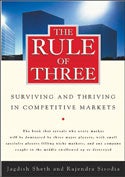
The Rule of Three: Surviving and Thriving in Competitive Markets
by Jagdish Sheth and Rajendra Sisodia
Free Press, 2002
288 pages, $28.00
Everyone from business school academics to the kid who stocks the shelves at your local supermarket seems to have an opinion about when companies should enter new markets. Unfortunately, it’s all contradictory. On the one hand, first movers have the advantage. On the other, pioneers get arrows in their backs.
Business school professors Jagdish Sheth of Atlanta’s Emory University and Rajendra Sisodia of Bentley College in Boston come at the problem differently. To them, when you enter the market is far less important than the size of market share you eventually acquire.
Naturally occurring competitive forces, they argue, will inevitably lead to a situation in which three companies dominate any given field. They list nearly 150 examples in an 11-page appendix that examines markets worldwide. Over and over, in fields ranging from U.S. communications equipment companies—Cisco Systems Inc., Nortel Networks Corp. and Lucent Technologies Inc.—to South Korean chipmakers—Goldstar (now part of LG Group), Hyundai Group and Samsung Group—three large firms have come to own 70 percent to 90 percent of the market. To be successful, everyone else is forced to specialize by product or market niche.
There are exceptions, of course. It’s the “Big 5” when it comes to accounting firms, and Coke and Pepsi basically own the U.S. soft drink market. These examples are hard to come by, however, and those that don’t fit the central argument are either quickly brushed aside or ignored by the authors.
So why three? The authors contend that markets are inherently efficient, and three competitors is the best number to promote and sustain that efficiency. Having two companies will lead either to monopoly pricing or to the two destroying each other, and more than three leads to overcapacity and perpetual price wars.
Thus, when faced with three established competitors in a field, you want to think long and hard about whether you’re willing to spend the money to knock one of them off. Consider instead becoming a product specialist (“We make the world’s best X”) or a niche player (“We only serve the Y market”). Trying to force your way in either by taking on a market leader directly or by expanding outside of your niche just doesn’t seem to be a wise use of resources, according to the research.
The authors also discuss strategies for the three major players in a field. A market-leading company will receive a higher return on assets if it is a “fast follower” rather than a consistent innovator, so CIOs at such companies should carefully monitor the technological innovations of their competitors. Meanwhile, CIOs at the number-three firm must create a technological atmosphere that facilitates the creation of new products, even though whatever it comes up with is likely to be copied by its competitors. The middle firm, the authors contend, needs to invest “disproportionately” in marketing, by focusing on key customers in key segments, for example, and thus IT must aid in that effort by working particularly closely with marketing.
While the writing ranges from crystalline to academic, the authors have come up with an interesting new way of looking at competition—as well as strategies for what to do about it.
